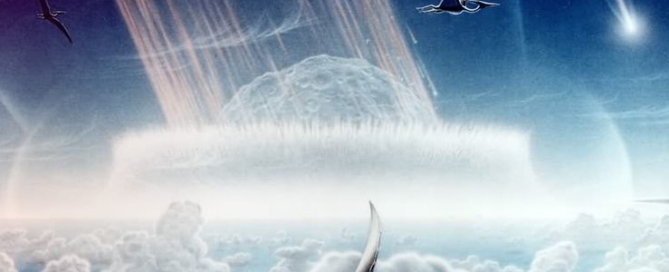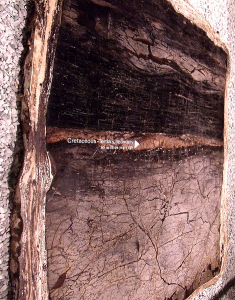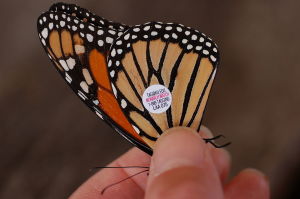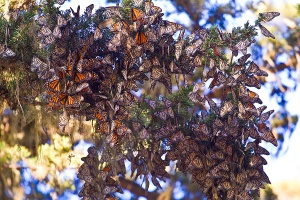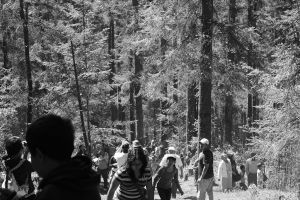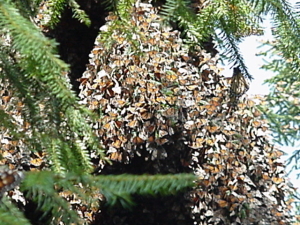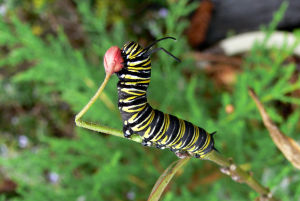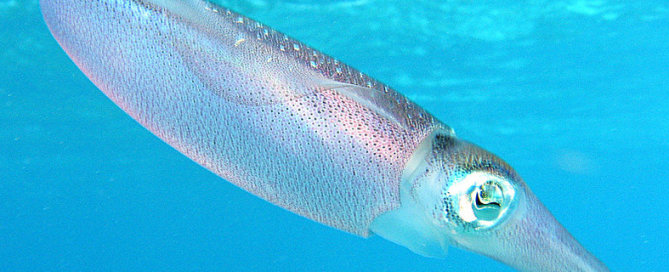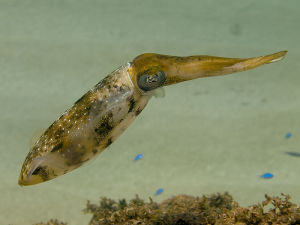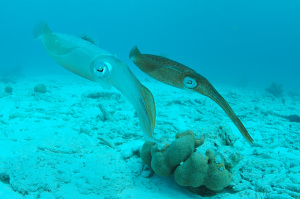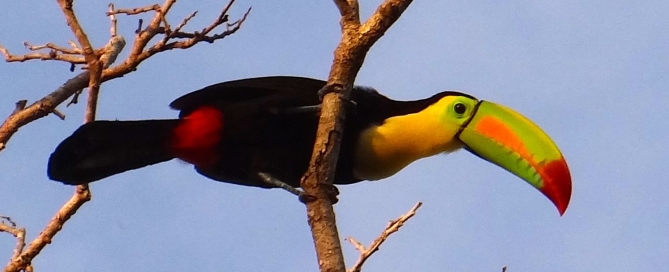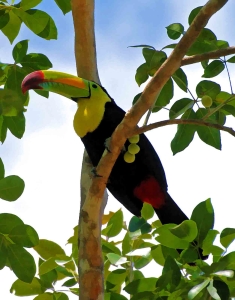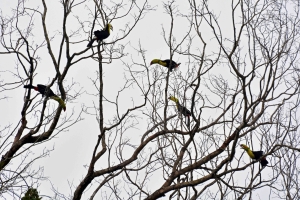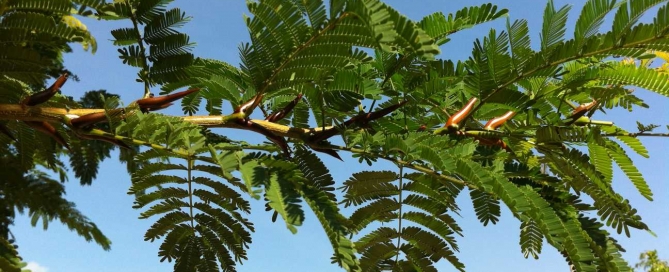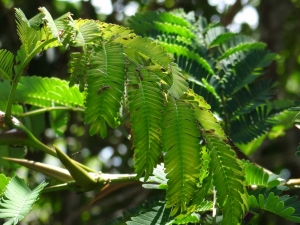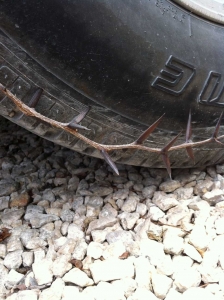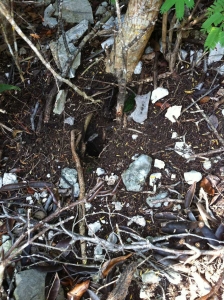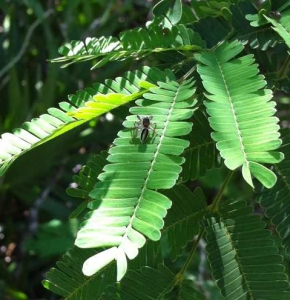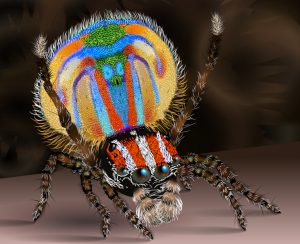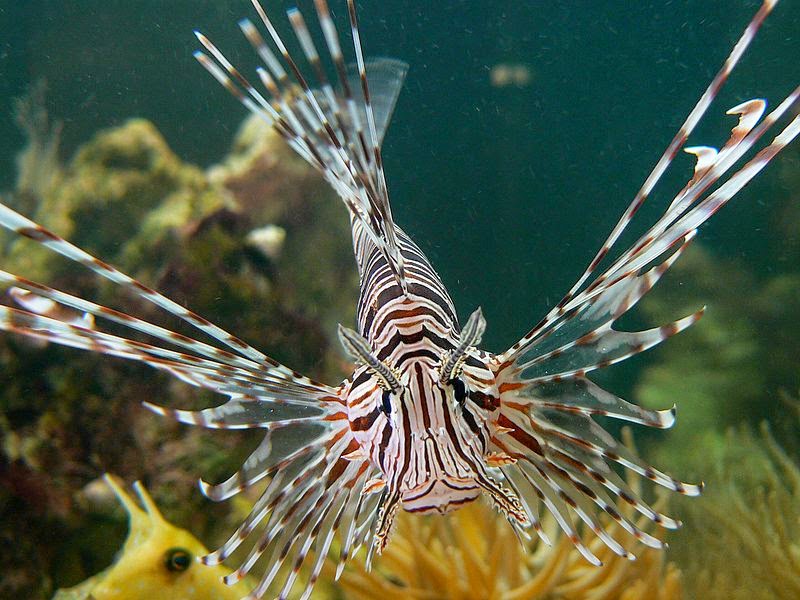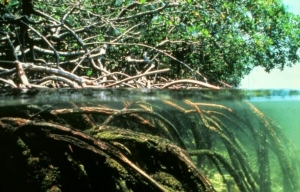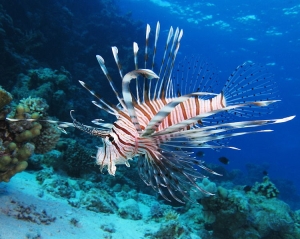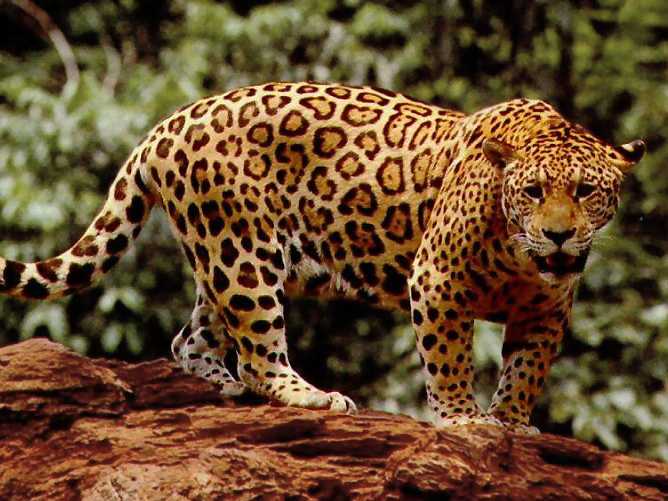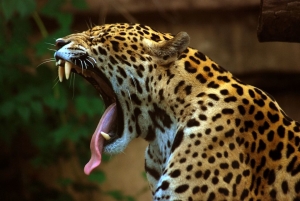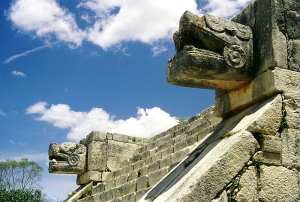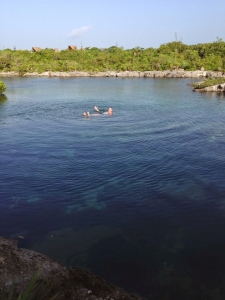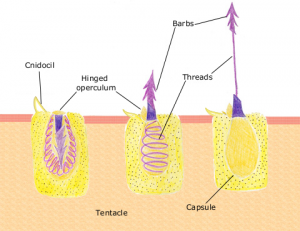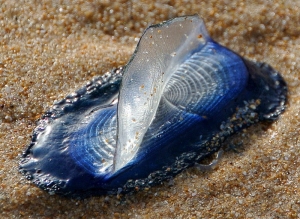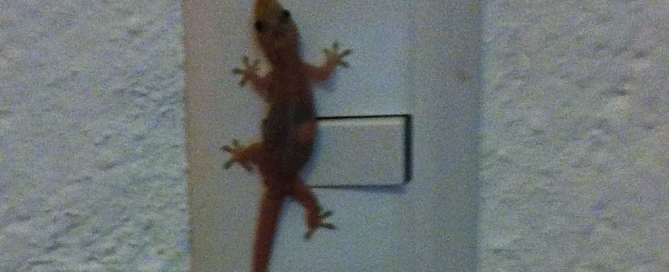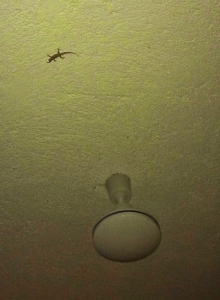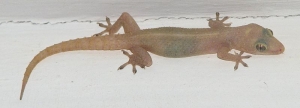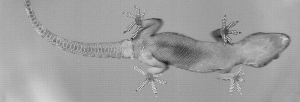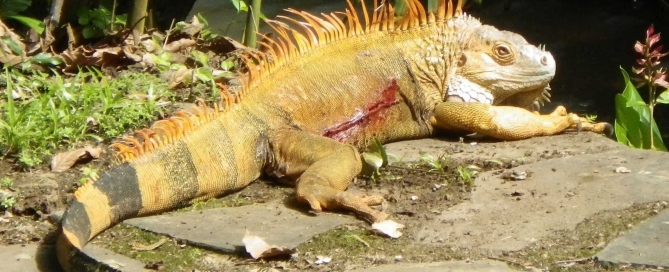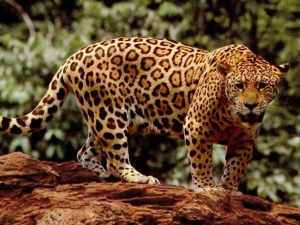A Bad Day on the Yucatan
I picture a dinosaur standing on the coast of what would become the Yucatan Peninsula. I always picture a brontosaurus, I’m not sure why, and in my mind’s eye she cranes her long neck back over her shoulder to the south-east, and up toward the sky. The gleaming object that has captured her attention is actually seven and a half miles across and is made of rock that is fifteen percent denser than the rock she is standing on, but all she sees is a gleam because it is travelling at 44,640 miles per hour and is surrounded by a shock layer that has been brought to incandescence by compression wave heating and is now at 35,500 degrees Fahrenheit, and is so bright that it is getting a little bit painful to look at. She is a brachiopod, so her encephalization quotient, which is the ratio of body size to brain size, is only 0.1. She’s not the brightest bulb in the Yucatan even by dinosaur standards, but I picture her having a very uneasy feeling about this.
The object passes over her in complete silence, being well over two hundred thousand feet above her, and in the next several seconds, as she tracks it with her tiny head and long, long neck, it burns through ever denser atmosphere, getting more and more brilliant as it plummets to the northwest, and then, at a spot fifty miles out to sea from where she is standing, it impacts.
There is a flash roughly as bright as the surface of the sun, and a reflective dome appears to rise into the sky above it and then dissipate. The sea is pulverized into a miasma along the horizon beneath it. But still she hears nothing. A widening cone of shattered rock and water rises skyward, upward and outward, in slow motion. Still there is silence, but a shimmering layer of air at ground level appears to be getting taller, and that’s because it’s getting closer—it is the leading edge of a ring-shaped blast wave moving outward at 16,700 miles per hour (I worked all this out). She gazes at its approach for long moments, and still there is only silence. It takes 10.8 seconds for the blast wave to reach her, but even then what finally hits her could not really be called sound, because sound travels at only one twentieth that speed, and besides, when this thing hits her, she does not hear or feel a thing. The impact kills her instantly, and then the heat sears the flesh from her bones.
The Gulf of Mexico is 1,500 feet deep where this great meteorite hits, which sounds like a lot of water, but it’s only one twenty-sixth the diameter of this rock. To put that another way, as its leading surface strikes the sea, its trailing surface is still at an elevation of 40,000 feet. The ocean is a mere puddle, almost inconsequential to this impact event.
The temperature at the impact site hits fourteen thousand degrees Fahrenheit, and everything within a 1,000 mile radius is immediately incinerated just by the flash. One hundred and ten cubic miles of rock is melted into a sheet three miles thick. Forests are flattened in a radial pattern out to 6,200 miles. The rock thrown skyward in the widening ejecta cone hits twenty-five thousand miles per hour in its ascent, and a lot of it ends up in orbit. Some of it even achieves escape velocity and is never seen by the planet Earth again. Some of it is on the moon today.
After the initial flash, super-heated winds race outward from the impact site at up to 2,000 miles per hour, and more forests are ignited. An earthquake of somewhere between magnitude 10 and 12, depending on who you talk to—which are magnitudes never experienced in recorded history—rocks the planet all the way from northern Canada to the mid-latitudes of South America. Oceanographic events that have been called “mega-tsunamis” hit the coasts of what are now Mexico, Texas, Alabama and Lousiana, and they are 300 feet high, but scientists figure we got off easy because the meteorite did not have much water to work with. If it had hit in deep water, the height of those waves might have been two to three miles. The ejecta that did not achieve orbit begins to fall back to earth pretty quickly, and fiery rocks rain down across the western hemisphere for hours after the impact, igniting more forests. It is the cretaceous period (actually, it is the last day of the cretaceous period), and oxygen levels in the cretaceous period were high—30 to 35 percent, as opposed to today’s 21 percent. The forests flash easily into flame, and the firestorms race in sheets across the landscape, but the inferno is limited, so far, to the Americas.
Then the orbiting rocks begin to re-enter the atmosphere.
Unlike the earlier events, the meteor shower is world-wide. The meteors, so recently blasted up into Earth orbit, start to rain down as if the sky is burning, in such numbers that they not only start spot fires everywhere they hit, but they also heat the atmosphere itself, to the point that surface temperatures reach several hundred degrees, and whole forests flash spontaneously into flame. Soot, smoke and the dust of the original explosion rise in great towers and plumes into the upper atmosphere. The sea floor of the Gulf of Mexico is now circling the globe at two hundred thousand feet. The occlusion is complete—zero light is reaching the earth. For up to two months you cannot see your hand in front of your face, and for up to a year photosynthesis is impossible world-wide. Whole food chains collapse, on a continental scale. Temperatures plummet and previously balmy areas freeze over. This “impact winter” would last about ten years, but even that isn’t the end of things.
The reason that isn’t the end of things is that those fires have also released as much carbon dioxide as three thousand years of fossil fuel burning. In addition, the carbonate and evaporite rocks of the Yucatan get vaporized by the explosion into yet more carbon dioxide, and Yucatan rock also contains a lot of sulfur, and that gets blown into the upper atmosphere as sulfur dioxide, then combines with water to create sulfuric acid. It will fall a few years later as acid rain, but in the meantime, the droplets reflect away the sunlight, contributing further to the darkening of the earth. All told, ten trillion tons of carbon dioxide, one hundred billion tons of methane gas (which, by the way, is a much more powerful greenhouse gas than carbon dioxide) and one trillion tons of carbon monoxide end up in the upper atmosphere. So as the Earth recovers from the explosion, then from the fire storms, then from the wash of acid rain, and climbs painfully, over a period of ten years, out of the dark and freezing impact winter, it is only to enter a period of global warming that would last not decades, but centuries.
What’s amazing is that anything survived.
* * * *
Sixty-five million years later, give or take a couple, it was the late 1970’s, and a guy named Walter Alvarez was poking around near the town of Gubbio in Italy. He was a geologist, and what he was studying in Italy was the tectonics of the Mediterranean region, but what he kept wondering was a little off-topic. Why, he kept asking himself, is there this layer of unique clay exactly at the boundary of the cretaceous and the tertiary periods? The cretaceous-tertiary, or “KT,” boundary is, after all, a fairly auspicious moment in Earth’s history—it’s when the dinosaurs died. It was one of the most important extinction events in the history of life. (It was not the biggest—that was the Great Oxygen Catastrophe that gave us the air we breathe.) It had been suggested by a few lonely voices that the KT extinction might have been created by an asteroid impact, but it was a pretty fringe theory. Two geologists named Kelly and Dachille had noted in 1953 that something had hit the Earth back then hard enough to slightly alter its axis of rotation. But theories don’t go far in the scientific community until they’re backed up. Especially over-dramatic theories involving global catastrophes. No one was paying much attention. But Walter Alvarez couldn’t leave it alone. He was just sure this layer of clay held the key.
He did what I used to do when something was bugging the hell out of me: he called his dad.
* * * *
Luis Alvarez was a Nobel prize-winning physicist. He did things with people like Enrico Fermi and Robert Oppenheimer that I can’t even explain to you, including discovering whole new families of particles, but he was one of those guys who was too gifted to be constrained by his own profession, so he did a lot of work in other fields, especially during World War II. He invented “Friend or Foe” radar beacons, which are now on just about every aircraft in the world and are called transponders. (He held the patent for it, and signed it over to the government for one dollar.) He also developed ground controlled approach, or GCA, making it possible to land aircraft in low-visibility conditions, which was a pretty big game-changer in WWII. And, like most men of our fathers’ wartime generation, his work had its dark side. He invented explosive lenses. He worked out a way to keep enemy submarines from knowing they’d been found by microwave radar. And, inevitably, he ended up on the Manhattan Project, developing the atomic bomb.
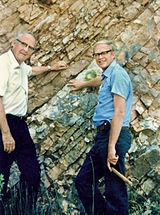
-
Luis and Walter Alvarez at the KT Boundary Photo courtesy of Lawrence Berkeley Laboratory, public domain
It was a brilliance that ran in the family. He descended from a long line of gifted people. His grandfather was a physician who did breakthrough work in Hawaii on leprosy. His great aunt Mabel was an impressionist painter. His great uncle Walter was a founder of the Mayo Clinic. And now his son was a little over a year away from becoming famous.
But it was physics the senior Alvarez brought to bear when his son put the KT extinction problem in front of him. The first thing the two of them decided to find out was how long it had taken for that layer of clay to get deposited. Fortunately, there’s a very convenient clock in the geological record, and it’s called iridium. Iridium is an element that almost does not exist in the Earth’s crust because it’s very heavy, and it all sank to the Earth’s core early in the planet’s history. But it exists in great quantities in all the rocks in outer space, which means in comets and asteroids, which means in all the shooting stars that burn up in our skies all the time. There is a constant light drizzle of iridium sifting down onto our earth’s surface from outer space all year, every year, and it’s quite steady and predictable. You can tell how long a layer of strata was sitting there exposed to the sky by measuring the amount of iridium in it. When they ran a sample of the KT clay, they were expecting to find that it had taken about ten thousand years to get laid down. The number that came back was four million. They were flabbergasted. There was no way that half-inch layer of clay had taken that long to get laid down. But there was another obvious explanation for all that iridium:
It was from an asteroid that impacted the earth.

-
Mabel Alvarez
See page for author [Public domain], via Wikimedia Commons
Now they were really interested. They roped in two colleagues of Luis’s, nuclear chemists Frank Asaro and Helen Michel. Together, they used a technique called neutron activation analysis to identify the concentrations of all the elements in the clay. They found that the extra-terrestrial quantities of iridium were only the beginning of the revelations. The clay also contained minerals like glassy spherules, shocked quartz and micro diamonds, all of which are only created under horrific amounts of heat and pressure. And they also ran some numbers on the soot. Taken world-wide—and this layer did seem to exist world-wide—that layer of clay contained enough soot to suggest that the “entire terrestrial biosphere burned.” In layman’s terms: every plant on earth.
In 1980 they published a paper, and the shouting commenced. Some think that one reason that this debate was even more acrimonious than most was that there had not been a single paleontologist involved in this discovery. They had all been scooped by a geologist and his physicist dad. But then scientists never take major shifts like this one quietly, and shouldn’t. Arguing is what we pay our scientists for. That’s part of scientific rigor. It’s what distinguishes science from religion. They argued for a decade. What finally happened was someone found the crater.
* * * *
Actually, the crater had been found two decades earlier, it just hadn’t been announced. The data had been sitting somewhere in the archives of Pemex, Mexico’s state-owned oil company, since the 1960’s, in the form of a “gravity map,” which maps the densities of underground rock by looking at gravitational anomalies.
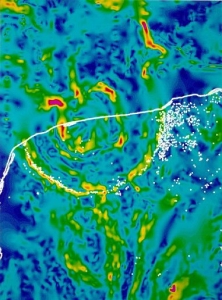
-
Chicxulub Crater Gravity Map
The white dots are cenotes created by the impact. The white line is the coastline.
By Milan Studio.Milan studio at en.wikipedia. [Public domain], from Wikimedia Commons
The problem is that oil companies, for obvious reasons, consider their discoveries proprietary, and keep them secret.
A Pemex person named Glen Penfield stumbled across the crater again in 1978 while doing a magnetic survey of the region. He saw the arc of the crater, and laid his hands on the gravity map, and another map of the peninsula itself, and lined up the two maps. The two arcs connected perfectly. They created a great circle, half under the ocean and half under the peninsula, with the small coastal town of Chicxulub near its center. That’s next to Progreso, where the cruise ships come in, 150 miles northwest of Susan and I.
To his credit, Glen Penfield argued to make the information public, and to Pemex’s credit, they finally did allow him to present it without specifics at a conference of the Society of Exploration Geophysicists in 1981. But the talk was lightly attended because, ironically, most of the experts on impact craters were at another conference that was scheduled for the same time—a conference on impact craters. Penfield’s presentation was barely noticed. He went back to work.
The funny thing is that at almost the same time that Penfield had been presenting, a grad student named Alan Hildebrand had gotten interested in finding this crater, and was out there soliciting information on “candidate craters.” But he and Penfield did not connect until nine years later when a Houston Chronicle reporter with one of those amazing reporter’s memories hooked them up. Finally, in 1991, the dots had been connected. They had their crater.
The senior Alvarez had passed away three years before.
* * * *
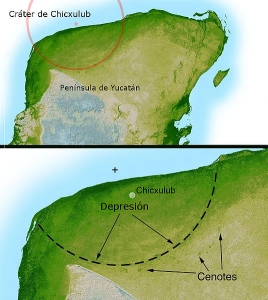
-
The Chicxulub Crater
By Yucatan_chix_crater.jpg: NASA/JPL-Caltech, modified by David Fuchs at en.wikipedia derivative work: Mircalla22 (Yucatan_chix_crater.jpg) [Public domain], via Wikimedia Commons
Seventy percent of species on the planet, both plant and animal, perished in this event or in the period following it. All the dinosaurs went extinct except the ones who became birds. This is a fun thing to reflect on: when you look at a cute and pretty songbird in your garden, you’re looking at the only dinosaur tough enough to survive the most horrific event in the planet’s history.
Not that evolution thinks or plans ahead, but for what it’s worth, there are great lessons in who survived and who did not. Anything large that was walking on dry land bit the dust. For them, there was just nowhere to hide. The largest vertebrates to survive were the crocodiles, for reasons that still serve them well today (they are largely unchanged): they are semi-aquatic, so they had somewhere to hunker during the worst of it. They are cold-blooded and can go long periods without food. They can get by on detritus and carrion, and they lay their eggs underground.
The same general principles applied to the creatures in the oceans. The large, surface-dwelling creatures perished, but farther down in the water column, and on the bottom, things went better, as those organisms rely more on carrion and detritus, which did not immediately vanish.
Specialists, for the most part, all went extinct. Pure predators who needed a steady supply of living prey all perished. Similarly, pure herbivores also had a rough time finding a plant for about a decade, and they all disappeared. But the generalists and opportunists who could change their habits in a pinch—those are the ones who survived.
One of them was a group of small, shrew-like, hair-covered, burrowing creatures. They were called mammals.
And that’s interesting to reflect on too. Not only did that tweety-bird in your garden survive the most hideous catastrophe imaginable—but so did you.
Now you know.

